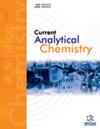Computational Analysis of Marburg Virus Envelope Glycoproteins: Insights from Bioinformatics and Genomics
IF 1.7
4区 化学
Q3 CHEMISTRY, ANALYTICAL
引用次数: 0
Abstract
Background: Marburg virus (MARV), which is spread by one species of fruit bats, can cause deadly Marburg virus disease (MVD, also known as Marburg hemorrhagic fever, MHF), which is a severe form of viral hemorrhagic fever with symptoms similar to Ebola. MARV is considered to be very dangerous, and there are no approved vaccines or antiviral treatments for Marburg disease. Objective: Computational studies were conducted to comprehend the envelope glycoproteins GP1 and GP2 expressed by the Marburg virus. Methods: Determination of the predicted intrinsic disorder predisposition of each glycoprotein sequence (PIDP) and the Polarity Index Method Profile 3.0v (PIM 3.0v) using genomics software and multiple computer algorithms, several of which have been specifically designed for this purpose. Results: The PIM 3.0v and PIDP profiles showed different MARV envelope glycoprotein patterns. These patterns revealed structural and morphological commonalities. Conclusions: Our computer systems were able to identify MARV envelope glycoprotein isolates using the PIM 3.0v profile, and they suggest that they can be used as a first-step filter for identifying them from databases or building synthetic proteins.马尔堡病毒包膜糖蛋白的计算分析:生物信息学和基因组学的启示
背景:马尔堡病毒(MARV)由一种果蝠传播,可引起致命的马尔堡病毒病(MVD,又称马尔堡出血热,MHF),这是一种严重的病毒性出血热,症状类似埃博拉病毒。马尔堡病毒病被认为非常危险,目前还没有获准用于治疗马尔堡病的疫苗或抗病毒疗法。研究目的进行计算研究以了解马尔堡病毒表达的包膜糖蛋白 GP1 和 GP2。方法使用基因组学软件和多种计算机算法(其中有几种算法是专门为此目的设计的)确定每种糖蛋白序列的预测内在紊乱倾向性(PIDP)和极性指数法简介 3.0v(PIM 3.0v)。结果PIM 3.0v 和 PIDP 图谱显示了不同的 MARV 包膜糖蛋白模式。这些模式显示了结构和形态上的共性。结论:我们的计算机系统能够识别 MARV:我们的计算机系统能够利用 PIM 3.0v 图谱识别 MARV 包膜糖蛋白分离物,这表明它们可用作第一步过滤器,从数据库中识别它们或构建合成蛋白质。
本文章由计算机程序翻译,如有差异,请以英文原文为准。
求助全文
约1分钟内获得全文
求助全文
来源期刊

Current Analytical Chemistry
化学-分析化学
CiteScore
4.10
自引率
0.00%
发文量
90
审稿时长
9 months
期刊介绍:
Current Analytical Chemistry publishes full-length/mini reviews and original research articles on the most recent advances in analytical chemistry. All aspects of the field are represented, including analytical methodology, techniques, and instrumentation in both fundamental and applied research topics of interest to the broad readership of the journal. Current Analytical Chemistry strives to serve as an authoritative source of information in analytical chemistry and in related applications such as biochemical analysis, pharmaceutical research, quantitative biological imaging, novel sensors, and nanotechnology.
 求助内容:
求助内容: 应助结果提醒方式:
应助结果提醒方式:


